WIPO Journal - World Intellectual Property Organization
WIPO Journal - World Intellectual Property Organization
WIPO Journal - World Intellectual Property Organization
Create successful ePaper yourself
Turn your PDF publications into a flip-book with our unique Google optimized e-Paper software.
The Economic Effects of Geographical Indications on Developing Country Producers 159<br />
GIs as specified in TRIPS (s.3) have two distinct degrees of protection, a higher one for wines and<br />
spirits (also known as appellations of origin) and one for other eligible products, those for which “a given<br />
quality, reputation, or other characteristic of the good is essentially attributable to its geographic origin”<br />
(art.22(1)). A higher level of protection means GIs “should be protected even if there is no risk of misleading<br />
consumers or unfair competition”. 4 Applications are typically to food and other agricultural products, but<br />
not exclusively so. The additional protection presently accorded to wines and spirits includes preventing<br />
the use of GIs for products even when the true source of origin is indicated, used in translation or<br />
accompanied by expressions like “kind”, “type”, “style”, “imitation” or similar phrases, and a prohibition<br />
for the GI name becoming generic. 5<br />
During the now-suspended WTO Doha Round negotiations, the European Union (EU) representatives<br />
sought to have the level of protection for all eligible products enhanced in three ways:<br />
• extension of the level of protection currently available for wines and spirits to other goods;<br />
• rolling back of a limited set of GIs in use in countries where the GIs did not originate; and<br />
• creation of a multilateral registration system for GIs.<br />
The EU emphasis on GIs revived interest in their functioning and economic ramifications. 6 Interest is<br />
focused not only on the EU and the United States, but on developing countries as well because the EU<br />
takes the position that enhanced GI protection will benefit developing countries, which can potentially<br />
enhance export markets for products like Oolong tea (China), and Basmati rice and Darjeeling tea (India).<br />
GIs are seen as particularly applicable to developing country agriculture because ownership of the mark<br />
is by the group and not the individual, and because the established standards make it possible to standardise<br />
quality across a large number of small suppliers.<br />
With the apparent suspension of the Doha Round the likelihood of enhancing GIs multilaterally is very<br />
much in doubt. However, the functionality, including the economic effects, of the current systems is poorly<br />
documented. The understanding of their impacts on developing countries is even more incompletely<br />
documented. Policy-makers in both developed and developing countries have identified GIs as a potential<br />
mechanism to assist primarily the agricultural sector in developing countries by reducing supply competition<br />
for traditional products while raising/standardising the quality of those products. The perception seems<br />
to be that GI benefits will flow primarily to smallholders in local communities as a form of rural<br />
development, but the correctness of that assumption, which is to say the projection of the distribution of<br />
benefits from the use of GIs, has to date not been analysed empirically. The objective of this study is to<br />
estimate the distribution of benefits from using GIs among factor owners and consumers. Our contribution<br />
is to document the resulting benefit distributions using two GIs operating with different levels of land<br />
supply. A secondary objective is demonstrating how our methodology can be applied to assess the benefit<br />
distribution for other GIs. We use a two-factor market displacement model of agricultural policy; while<br />
the model is perfectly general, the configuration we use is applicable only to agriculture. 7<br />
The use of an economic model configured for analysis of agricultural GIs has several ramifications for<br />
our objectives. The model functions with several quantifiable inputs, components of production, the<br />
broadest being land, labour and capital. Then it computes how benefits generated are distributed among<br />
those inputs. The analysis is useful for determining just who the major beneficiaries are and, with additional<br />
cost data, whether the benefits justify investments in, say, advertising or market channel development.<br />
Conversely, the results can indicate that, even if there is a net financial gain, the benefit recipients may<br />
4 “The Doha Declaration Explained”, at http://www.wto.org/english/tratop_e/dda_e/dohaexplained_e.htm#top [Accessed March 28, 2011].<br />
5 See Correa, Trade Related Aspects of <strong>Intellectual</strong> <strong>Property</strong> Rights, 2007.<br />
6 W.A. Kerr, “Enjoying a Good Port with a Clear Conscience: Geographic Indicators, Rent Seeking, and Development” (2006) 7(1) Estey Centre<br />
<strong>Journal</strong> of International Law and Trade Policy 1, at http://ageconsearch.umn.edu/bitstream/23827/1/07010001.pdf [Accessed March 28, 2011].<br />
7 Note for example that 80% of 82 current Indian GIs are for non-food products, mostly handicrafts. See http://docs.google.com/View?docid=dc39jv73<br />
_6f75sk3s2 [Accessed March 28, 2011]. Since in our model we use supply shifters such as input (land) quota, the current configuration is more applicable<br />
to agriculture.<br />
(2011) 2 W.I.P.O.J., Issue 2 © 2011 Thomson Reuters (Professional) UK Limited

















